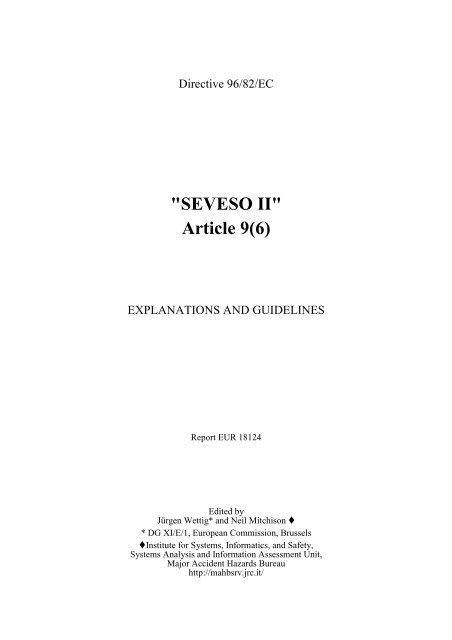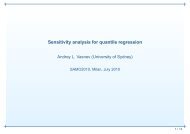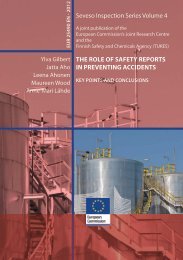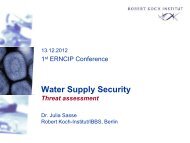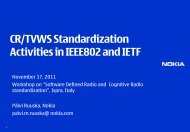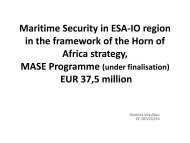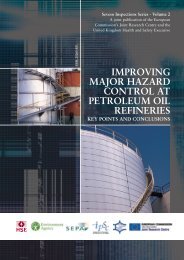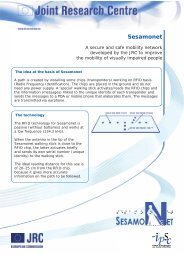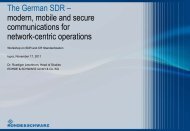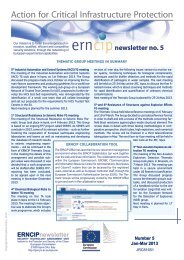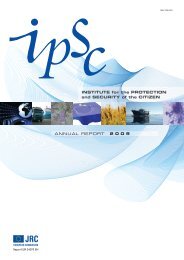Directive 96/82/EC "SEVESO II" - IPSC - Europa
Directive 96/82/EC "SEVESO II" - IPSC - Europa
Directive 96/82/EC "SEVESO II" - IPSC - Europa
Create successful ePaper yourself
Turn your PDF publications into a flip-book with our unique Google optimized e-Paper software.
<strong>Directive</strong> <strong>96</strong>/<strong>82</strong>/<strong>EC</strong><br />
"<strong>SEVESO</strong> II"<br />
Article 9(6)<br />
EXPLANATIONS AND GUIDELINES<br />
Report EUR 18124<br />
Edited by<br />
Jürgen Wettig* and Neil Mitchison J<br />
* DG XI/E/1, European Commission, Brussels<br />
JInstitute for Systems, Informatics, and Safety,<br />
Systems Analysis and Information Assessment Unit,<br />
Major Accident Hazards Bureau<br />
http://mahbsrv.jrc.it/
LEGAL NOTICE<br />
Neither the European Commission nor any person<br />
acting on behalf of the Commission is responsible for the use which might<br />
be made of the following information<br />
A great deal of additional information on the European Union<br />
is available on the Internet.<br />
It can be accessed through the <strong>Europa</strong> server<br />
(http://europa.eu.int)<br />
Cataloguing data can be found at the end of this publication<br />
Luxembourg: Office for Official Publications of the European Communities, 1999<br />
ISBN 92-<strong>82</strong>8-5900-2<br />
European Communities, 1999<br />
Printed in Italy
Table of Contents<br />
Foreword (English)<br />
List of members of TWG 6 (English)<br />
Explanations and Guidelines (English)
Foreword<br />
From 3 February 1999, the obligations of the "Seveso II" <strong>Directive</strong> (<strong>96</strong>/<strong>82</strong>/<strong>EC</strong>) will become mandatory for<br />
industry as well as the public authorities of the Member States responsible for the implementation and<br />
enforcement of the <strong>Directive</strong>.<br />
The adoption of the Commission Decision of 26 June 1998 on harmonised criteria for dispensations<br />
according to Article 9 of the "Seveso II" <strong>Directive</strong> represents the last step necessary to make all provisions<br />
of the <strong>Directive</strong>, in particular the 'dispensation rule' of Article 9, paragraph 6 fully operational.<br />
In order to contribute to a better understanding of the 'dispensation rule' as well as the Commission Decision<br />
on harmonised criteria, this document called "Explanations and Guidelines" has been elaborated by the<br />
same Technical Working Group (TWG 6) that prepared the harmonised criteria. The text of Article 9,<br />
paragraph 6 of the <strong>Directive</strong> and the Commission Decision can also be found in this document.<br />
In particular, the guidance clarifies that<br />
• an establishment benefiting from a dispensation remains subject to the provisions of the Seveso II<br />
<strong>Directive</strong> - see §1,<br />
• an establishment benefiting from a dispensation will in general still be obliged to submit a Safety Report<br />
(containing limited information) - see §4.3,<br />
• a dispensation cannot be granted on the basis of "active" safety measures, such as sprinklers - see §4.2.<br />
This guidance is not legislation. It should not be considered mandatory and does not preclude other<br />
reasonable interpretations of the requirements in the <strong>Directive</strong>.<br />
I would like to thank all members of TWG 6 (see list next page) for their commitment and valuable<br />
contributions to this document.<br />
for DG XI.E.1<br />
Jürgen Wettig,<br />
Chairman of TWG 6
TWG 6<br />
Chair: Jürgen Wettig, European Commission<br />
Secretary:<br />
Members:<br />
Neil Mitchison, European Commission<br />
Colette Clementé Ministère de l'Aménagement du Territoire et de l'Environnement, France<br />
John Colreavy Health & Safety Authority, Ireland<br />
Bruno Deuster Umweltministerium Nordrhein-Westfalen, Germany<br />
Michel Geortay Ministère de la Région Wallonne, Belgium<br />
Hans Hagen Arbejdstilsynet, Denmark<br />
Alda Frazão Serviço Nacional de Protecção Civil, Portugal<br />
Barbro Köhler National Board of Occupational Safety & Health, Sweden<br />
Tomas Langard NERIS, France<br />
Gordon MacDonald Health & Safety Executive, UK<br />
André Muyselaar VROM,The Netherlands<br />
Jean-Philippe Pineau INERIS, France<br />
Päivi Rantakoski Safety Technology Authority, Finland<br />
Fernanda Rodrigues Serviço Nacional de Protecção Civil, Portugal<br />
Giuseppe Romano Comando Provinciale Vigili del Fuoco, Pisa, Italy<br />
Ernst Simon Amt der Steiermärkischen Landesregierung, Austria<br />
Pehr Olof Sundh National Board of Occupational Safety & Health, Sweden<br />
Clotilde Valleix Ministère de l'Aménagement du Territoire et de l'Environnement, France<br />
Roger Tregunno Department of the Environment, Transport and the Regions, UK<br />
Andrea Young Department of the Environment, Transport and the Regions, UK
EXPLANATIONS AND GUIDELINES<br />
FOR THE APPLICATION OF THE<br />
DISPENSATION RULE OF<br />
ARTICLE 9, PARAGRAPH 6 OF<br />
COUNCIL DIR<strong>EC</strong>TIVE <strong>96</strong>/<strong>82</strong>/<strong>EC</strong><br />
ON THE CONTROL OF<br />
MAJOR-ACCIDENT HAZARDS<br />
INVOLVING DANGEROUS SUBSTANCES<br />
1. Introduction<br />
Council <strong>Directive</strong> <strong>96</strong>/<strong>82</strong>/<strong>EC</strong> of 9 December 19<strong>96</strong> on the control of major-accident hazards involving<br />
dangerous substances1 (the "<strong>SEVESO</strong> II" <strong>Directive</strong>) aims at the prevention of major accidents and the<br />
limitation of their consequences for man and the environment, with a view to ensuring high levels of<br />
protection throughout the Community in a consistent and effective manner.<br />
Article 9 of the <strong>SEVESO</strong> II <strong>Directive</strong> requires that the operators of certain establishments that come under<br />
the scope of the <strong>Directive</strong> (so-called upper tier establishments; see chapter 3 "Scope" for a more detailed<br />
explanation) produce and periodically review a safety report and send it for examination to the national<br />
competent authority responsible for carrying out the duties laid down in the <strong>Directive</strong>.<br />
Article 9, paragraph 6 of the <strong>SEVESO</strong> II <strong>Directive</strong> provides for possible dispensations, i.e. limitations of the<br />
information contained in safety reports to be granted by the competent authorities of the Member States,<br />
upon request from operators of upper tier establishments. It contains the following provisions:<br />
a) Where it is demonstrated to the satisfaction of the competent authority that particular<br />
substances present at the establishment, or any part thereof, are in a state incapable of<br />
creating a major-accident hazard, then the Member State may, in accordance with the<br />
criteria referred to in subparagraph (b), limit the information required in safety reports to<br />
those matters which are relevant to the prevention of residual major-accident hazards and<br />
the limitation of their consequences for man and the environment.<br />
b) Before this <strong>Directive</strong> is brought into application, the Commission, acting in accordance<br />
with the procedure laid down in Article 16 of <strong>Directive</strong> <strong>82</strong>/501/E<strong>EC</strong>, shall establish<br />
harmonized criteria for the decision by the competent authority that an establishment is in<br />
a state incapable of creating a major accident hazard within the meaning of subparagraph<br />
(a). Subparagraph (a) shall not be applicable until those criteria have been established.<br />
c) Member States shall ensure that the competent authority communicates a list of the<br />
establishments concerned to the Commission, giving reasons. The Commission shall<br />
forward the lists annually to the Committee referred to in Article 22.<br />
The provision of Article 9 paragraph 6 is intended to avoid unnecessary administrative requirements if<br />
particular substances at a specific establishment are in a state incapable of creating a major-accident hazard.<br />
The decision concerning each establishment will be made by the competent Authority on a case-by-case<br />
basis. However, it is clear that any dispensation granted under this paragraph only relates to a limitation of<br />
information required in the Safety Report, and does not release the operator from other obligations under the<br />
<strong>Directive</strong>. The establishment will remain an upper-tier Seveso establishment.<br />
This document is intended to provide further explanations and guidance to assist with the interpretation of<br />
the dispensation rule contained in the <strong>Directive</strong>. The guidance is not legislation Whilst it is not mandatory<br />
and does not preclude other reasonable interpretations, it reflects the interpretation of the <strong>Directive</strong> as agreed<br />
by the European Commission and the Member State Authorities.
2. Procedure and Time Frame<br />
2.1. Procedure<br />
The procedure referred to in Article 9, paragraph 6, sub-paragraph (b) of the <strong>SEVESO</strong> II <strong>Directive</strong> required<br />
the Commission to submit a draft of the harmonized criteria to the Committee of Competent Authorities2<br />
(CCA) and the CCA to act as a Regulatory Committee3 (type IIIa) as set out in Article 16 of <strong>Directive</strong><br />
<strong>82</strong>/501/<strong>EC</strong> on the major-accident hazards of certain industrial activities4 (now known as the "<strong>SEVESO</strong> I"<br />
<strong>Directive</strong>). This article contains the following provision:<br />
Article 16<br />
1. Where the procedure laid down in this article is to be followed, matters shall be referred<br />
to the committee by the chairman, either on his own initiative or at the request of the<br />
representative of a Member State.<br />
2. The representative of the Commission shall submit to the committee a draft of the<br />
measures to be adopted. The committee shall deliver its opinion on the draft within a time<br />
limit which may be determined by the chairman according to the urgency of the matter. It<br />
shall decide by a majority of 54 votes, the votes of the Member States being weighted as<br />
provided for in article 148(2) of the treaty. The chairman shall not vote.<br />
3. a) The Commission shall adopt the measures envisaged where these are in accordance<br />
with the opinion of the committee.<br />
b) Where the measures envisaged are not in accordance with the opinion of the<br />
committee, or in the absence of an opinion, the Commission shall forthwith submit a<br />
proposal to the Council on the measures to be adopted. The Council shall act by a<br />
qualified majority.<br />
c) If the Council does not act within three months of the proposal being submitted to it,<br />
the measures proposed shall be adopted by the Commission.<br />
2.2. Time frame<br />
Article 9, paragraph 6, sub-paragraph (b) contains the obligation to adopt the harmonized criteria before the<br />
<strong>SEVESO</strong> II <strong>Directive</strong> is brought into application.<br />
The <strong>SEVESO</strong> II <strong>Directive</strong> entered into force on the 20th day following that of its publication in the Official<br />
Journal of the European Communities, i.e. on 3 February 1997. According to Article 24, the <strong>Directive</strong> has to<br />
be implemented by 3 February 1999; hence from that date the obligations of the <strong>Directive</strong> should have been<br />
imposed on the operators and the competent authorities of the Member States responsible for the<br />
implementation and enforcement of the <strong>Directive</strong>. At the same time the <strong>SEVESO</strong> I <strong>Directive</strong> will be<br />
repealed.<br />
The Commission Decision establishing the harmonized criteria was adopted on 26 June 1998, i.e. before 3<br />
February 1999. It was published in the Official Journal of the European Communities no.L192 on 8 July<br />
1998.<br />
2.3. Amendments to the harmonized criteria<br />
The harmonized criteria may be modified by the CCA, acting as a Regulatory Committee under Article 21<br />
of the Seveso II <strong>Directive</strong>. This procedure is similar to that described in 2.1 above.
3. Scope<br />
This section explains briefly the scope of the <strong>Directive</strong>, and the scope of any dispensation, i.e. in respect of<br />
what substances a dispensation may be granted. It does not cover the consequences of a dispensation.<br />
3.1. General explanation of the scope of the <strong>SEVESO</strong> II <strong>Directive</strong><br />
The scope of the <strong>SEVESO</strong> II <strong>Directive</strong> relates solely to the presence of dangerous substances in<br />
establishments. The term 'presence of dangerous substances' is defined as the actual or anticipated presence<br />
of such substances or the presence of substances which may be generated during loss of control of an<br />
industrial chemical process.<br />
Furthermore, the scope of the <strong>SEVESO</strong> II <strong>Directive</strong> follows a two-tier approach, which means that for each<br />
named substance mentioned in Annex I, Part 1 of the <strong>Directive</strong> and for each generic category of substances<br />
and preparations mentioned in Annex I, Part 2, two different qualifying quantities (threshold levels) exist, a<br />
lower and an upper tier.<br />
It is assumed that the hazard associated with an establishment increases with the quantities of substances<br />
present at the establishment. Consequently, the <strong>Directive</strong> imposes more obligations on upper tier<br />
establishments than on lower tier establishments.<br />
Article 9 only applies to upper tier establishments and these establishments are obliged to produce a safety<br />
report. Therefore only operators of such upper tier establishments can apply for a dispensation under Article<br />
9, paragraph 6.<br />
Therefore the first decision to be made is whether an establishment qualifies as an upper tier establishment.<br />
For this decision, all dangerous substances present at the establishment must be taken into account,<br />
irrespective of whether a dispensation may be applied for.<br />
3.2. Substances subject to a dispensation according to Article 9, paragraph 6<br />
Once an establishment qualifies as an upper tier establishment under the <strong>SEVESO</strong> II <strong>Directive</strong>, i.e. has one<br />
or more dangerous substances present in quantities equal to or above one or more qualifying quantities for<br />
the application of Article 9, the safety report must contain an updated inventory of the dangerous substances<br />
present in the establishment.<br />
In other words, all substances present at the establishment that are 'dangerous substances' as defined in<br />
Article 3, point 4 of the <strong>Directive</strong> must be considered even if their quantities do not meet the threshold levels<br />
set out in Annex I.<br />
It follows that a dispensation can relate to any dangerous substances present at an establishment, irrespective<br />
of the qualifying quantities of the <strong>Directive</strong>. It is worth noting that a substance present in one part of an<br />
establishment, say one particular installation, may qualify for a dispensation when the same substance<br />
elsewhere in the establishment does not.
4. Terms used in Article 9, Paragraph 6<br />
4.1. "... particular substances..."<br />
This term covers only dangerous substances as defined in Article 3, point 4 of the <strong>Directive</strong>.<br />
4.2. "... in a state incapable of creating a major-accident hazard..."<br />
A particular substance is deemed to be "in a state incapable of creating a major-accident hazard" if it fulfils<br />
any of the generic criteria set out in the Commission Decision of 26 June 1998.<br />
It may be demonstrated that particular substances are incapable of creating a major accident provided certain<br />
safety measures are in place and in effect. However, a dispensation will not be granted if the "state of<br />
incapability" relies on safety measures which are active in nature, such as sprinklers or fire doors.<br />
Whereas the term "incapable of creating a major accident hazard" in sub-paragraph (a) relates to particular<br />
substances, it relates to the establishment in sub-paragraph (b). When looking at the text in subparagraph (b)<br />
it is important to emphasize the wording "within the meaning of subparagraph (a)". The intent of<br />
subparagraph (b) is simply to state that harmonized criteria are required for the application of subparagraph<br />
(a).<br />
4.3. "... limit the information required in safety reports to those matters which are relevant to the<br />
prevention<br />
of residual major-accident hazards and the limitation of their consequences for man and the<br />
environment."<br />
A dispensation granted according to Article 9 paragraph 6 permits an operator to limit the information in the<br />
safety report to those matters which are relevant to the prevention of residual major-accident hazards. The<br />
term "residual major-accident hazards" can only relate to dangerous substances present at the establishment<br />
other than those for which the dispensation has been granted (either different substances or the same<br />
substance under different circumstances).<br />
Therefore, in general, a dispensation will not release the operator from the obligation to submit a Safety<br />
Report.
5. Criteria<br />
The approach chosen is to establish generic criteria rather than allowing dispensations for specific industries,<br />
sectors or activities. These criteria are flexible enough to encompass a wide range of industries, processes<br />
and substances within the scope of the <strong>SEVESO</strong> II <strong>Directive</strong>. A dispensation according to Article 9,<br />
paragraph 6 may be granted if at least one of the criteria set out below is fulfilled.<br />
5.1. Physical form of substance<br />
5.1.1. Criterion<br />
Substances in solid form, such that, under both normal conditions and any abnormal conditions which<br />
can reasonably be foreseen, a release, of matter or of energy, which could create a major-accident<br />
hazard, is not possible.<br />
5.1.2. Explanation<br />
The fact that the physical form of certain substances influences their major-accident potential is recognised<br />
in the <strong>SEVESO</strong> II <strong>Directive</strong>. For example, the entry for nickel compounds only in inhalable powder form in<br />
the list of named substances in Annex I, Part 1 of the <strong>Directive</strong> reflects the fact that these compounds when<br />
in solid form are incapable of creating a major-accident hazard, yet are classified as being toxic.<br />
5.2 Containment and Quantities<br />
5.2.1. Criterion<br />
Substances packaged or contained in such a fashion and in such quantities that the maximum release<br />
possible under any circumstances cannot create a major-accident hazard.<br />
5.2.2. Explanation<br />
This criterion can only be applied if the quantities taken out of containment at any one time are insufficient<br />
to create a major-accident hazard.<br />
This criterion could be applied to a store of containers of such size, construction, and contents that the<br />
release from a small number of containers would not in itself represent a major-accident hazard nor could it<br />
have any knock-on effects on other containers, provided that no reasonably foreseeable external aggression<br />
could release the contents of a large number of containers.<br />
5.3. Location and Quantities<br />
5.3.1. Criterion<br />
Substances present in such quantities and at such distances from other dangerous substances (at the<br />
establishment or elsewhere) that they can neither create a major-accident hazard by themselves nor<br />
initiate a major accident involving other dangerous substances.<br />
5.3.2. Explanation<br />
A large establishment consisting of several installations may have dangerous substances in small and<br />
isolated quantities at installations distant from those which represent the major-accident hazard potential,<br />
and also from any other hazardous establishments.<br />
The inability to cause a major accident, directly or indirectly, must apply to the substances concerned at all<br />
moments that they are present at the establishment. It should also be borne in mind that substances will have<br />
to be transported within the establishment, and during transport this criterion may not apply.<br />
5.4. Classification<br />
5.4.1. Criterion<br />
Substances which are defined as dangerous substances by virtue of their generic classification in Annex I<br />
Part 2, but which cannot create a major-accident hazard, and for which therefore the generic<br />
classification is inappropriate for this purpose.
5.4.2. Explanation<br />
Since the generic classifications of Annex I, Part 2 are based on the intrinsic hazard associated with a<br />
substance, there may be cases where this is not relevant in the context of a major accident.<br />
This criterion could apply to a substance which is classified as toxic, but for which the only hazard is<br />
toxicity by ingestion, provided that route of exposure can reasonably be excluded in the event of a major<br />
accident.<br />
This criterion cannot apply to substances which are listed in Annex I, Part 1.
6. Application for a dispensation according to Article 9, Paragraph 6<br />
6.1. Application by the operator of an upper tier establishment<br />
6.1.1. Time limits for the submission and review of safety reports<br />
For new establishments, the safety report has to be sent to the competent authority within a 'reasonable<br />
period of time' prior to the start of construction or operation.<br />
For existing establishments and installations previously covered by the <strong>SEVESO</strong> I <strong>Directive</strong>, the safety<br />
report has to be sent to the Competent Authority by 3 February 2001.<br />
For existing establishments not previously covered by the <strong>SEVESO</strong> I <strong>Directive</strong>, the safety report has to be<br />
sent to the Competent Authority by 3 February 2002.<br />
The safety report must be reviewed and, if necessary, updated<br />
• at least every five years or<br />
• at the initiative of the operator or at the request of the competent authority, where justified by new facts,<br />
new technical knowledge about safety or about hazard assessment, or<br />
in case of a modification of a site, which means modification of the establishment, the installation, the<br />
storage facility, the (chemical) process, the nature of dangerous substance(s) or the quantity of dangerous<br />
substance(s).<br />
6.1.2. Appropriate time of application for a dispensation<br />
The operator must submit an application for a dispensation to the competent authority within a reasonable<br />
period of time before the expiry of the deadline(s) before which he has to send the safety report to the<br />
competent authority. If the operator wishes, he may submit, along with this application, the limited safety<br />
report which may be required in the event of his application being successful.<br />
In this context, a reasonable period of time means that the competent authority must have sufficient time to<br />
examine the application, including, if necessary, further requests for information and/or on-site inspection,<br />
and, following the decision by the competent authority, the operator must have sufficient time to take<br />
account of this decision, i.e. to complete his safety report in the case of a negative decision or to make<br />
reference in the safety report in the case of a positive decision (see point 6.4. below).<br />
In the case of new establishments, the operator may prefer to submit the application for a dispensation<br />
together with a limited safety report. This is because in these cases - contrary to the cases where<br />
establishments are already in use - the bringing into use of the new establishment depends on the competent<br />
authority's communicating to the operator the conclusions of its examination of the Safety Report.<br />
Submitting the application for a dispensation together with a limited safety report may also be appropriate in<br />
the event of modifications to existing establishments.<br />
6.2. Contents of an application<br />
An application for a dispensation should include the following details:<br />
a) the name or trade name of the operator and the full address of the establishment concerned;<br />
b) the registered place of business of the operator, with the full address;<br />
c) the name or position of the person in charge of the establishment, if different from (a);<br />
d) a general description of the activities of the establishment, and specific information concerning the<br />
installation for which a dispensation is being sought;<br />
e) the immediate environment of the establishment, to the extent relevant to the application;<br />
f) description of the dangerous substance(s) for which a dispensation is requested:<br />
1. inventory of dangerous substances including<br />
- the identification of dangerous substances: chemical name, CAS number, name according to IUPAC<br />
nomenclature, classification;<br />
- the maximum quantity of dangerous substances present or likely to be present;<br />
2. physical, chemical, toxicological and ecotoxological characteristics;<br />
3. physical and chemical behaviour under normal conditions of use and under foreseeable accident<br />
conditions;
g) the criterion or criteria under which a dispensation is being sought;<br />
h) the operator's demonstration that the criterion is applicable (for each criterion concerned);<br />
i) the limitation of information in the safety report which is being requested.<br />
6.3. Reference in the safety report<br />
In any safety report for which the information required has been limited by a dispensation, reference should<br />
be made to the dispensation concerned.<br />
6.4. Information for the public<br />
As Member States shall ensure that the safety report is made available to the public, the public should also<br />
have access to the information that leads to permitting an operator to limit the information contained in the<br />
safety report, subject to restrictions concerning confidentiality.
7. Duties of the Competent Authorities when granting a dispensation<br />
The competent authority should examine the application put forward and should within a reasonable period<br />
after receipt of the application communicate the conclusions of its examination to the operator, if necessary<br />
after requesting further information and/or after making an on-site inspection.<br />
The administrative act by which a dispensation is granted should specify to which substance(s) the<br />
dispensation applies, what part of the establishment is concerned, what are the conditions of the<br />
dispensation's continuing validity, and what information is not required in the safety report.
8. Communication by the Member States of a List of Establishments for which<br />
dispensations have been granted to the Commission; Information from the<br />
Commission to the Committee of Competent Authorities (CCA)<br />
8.1. Notification of establishments for which dispensations have been granted<br />
The Member States will notify dispensations granted to the Commission.<br />
The notification should be made as soon as possible after the dispensation has been granted. It should<br />
contain the following details:<br />
a) the name or trade name of the operator and the full address of the establishment concerned;<br />
b) a brief general description of the activities of the establishment, and information concerning the<br />
installation for which a dispensation has been granted;<br />
c) the particular dangerous substance(s) for which a dispensation has been granted;<br />
d) the reasons for the dispensation, with reference to the harmonised criteria.<br />
8.2. Information for the Committee of Competent Authorities (CCA)<br />
The Commission will establish a database containing information on dispensations notified by the competent<br />
authorities of the Member States.<br />
A consolidated list of establishments for which dispensations have been granted will be forwarded to the<br />
Member States on an annual basis. It will contain the information mentioned under point 8.1 above.<br />
8.3. Review of the scope of the <strong>SEVESO</strong> II <strong>Directive</strong> in specific cases<br />
Should cases be notified to the Commission where operators of upper tier establishments can demonstrate<br />
that all dangerous substances present at their establishment are in a state incapable of creating a majoraccident<br />
hazard and that therefore no major-accident potential resides, the Commission will review the scope<br />
of the <strong>SEVESO</strong> II <strong>Directive</strong> in the light of these cases, and submit a report on the subject to the CCA.
European Commission<br />
EUR 18124 – Explanation and guidelines for the application of the dispensation rule of article 9, Par. 6 of<br />
Council <strong>Directive</strong> <strong>96</strong>/<strong>82</strong>/<strong>EC</strong><br />
N. de gestion: 1999/1054<br />
J. Wettig, N. Mitchison<br />
Luxembourg: Office for Official Publications of the European Communities<br />
1999 – 162 pp. – 16.2 x 22.9 cm<br />
Environment and quality of life series<br />
ISBN 92-<strong>82</strong>8-5900-2<br />
This document addresses the harmonized criteria which the European Commission has established for the<br />
application of the dispensation rule of <strong>Directive</strong> <strong>96</strong>/<strong>82</strong>/<strong>EC</strong> ("Seveso II"). The document has been drawn up<br />
by a Technical Working Group (TWG) of representatives from the Commission and from Member States.<br />
After a foreword in English from Jürgen Wettig of DG XI/E/1 Chairman of the TWG, the document<br />
presents, in all 11 official languages of the European Union, the text of the Official Journal with the<br />
Commission’s decision, and a document explaining this decision and giving guidelines as to procedures to<br />
be followed.


